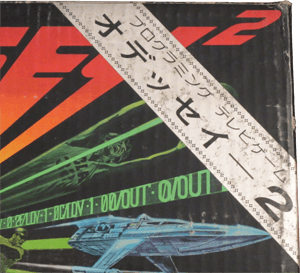Understanding the Odyssey² in Japan

For years, the importer behind the Odyssey² in Japan has been identified as "Kooton", a name found by translating the text on the back of Japanese manuals into English. However, the company's name is actually "Corton", a name that appears in other period English-language sources [1, 2]. "Kooton" is an overly literal translation that came about due to the complexities of converting Japanese text into English.
Translation Trickiness
This chart shows text on the back of Japanese Odyssey² manuals:
| Japanese Text | English Translation | Pronunciation [4] |
|---|---|---|
| 輸入元: タリーエンターブライズ | Import Source: Tally Enterprise | "Tarī Entāpuraizu" |
| ディビジョン | Division | "Dibizon" |
| コートン トレーディング カンパニー | Corton Trading Company | "Kōton torēdingu kanpanī" |
| 東京都新宿区原町3—14—2 EDビル | 3-14-2 Haramachi Shinjuku-ku, Tokyo Building ED Building |
The katakana alphabet is often used in Japan to spell words from non-Japanese languages. Usually the purpose of the translation is not to match the spelling letter-for-letter, but to adapt the word's pronunciation into syllables that a Japanese speaker would use. In katakana, the first syllable of "Corton" is spelled using the Japanese elongated or "double" O, which explains the spelling "Kooton" when translated back to English. Despite how it may look to readers of English, a Japanese speaker would pronounce this syllable closer to "cor" than to "coo".
Sometimes the names "Taitari" and "Dingu" have been associated with the Odyssey² in Japan. These also result from improper translation. In Japan, Corton apparently distributed video games under a local brand named Tally Enterprise. There is no "L" sound in spoken Japanese, so in katakana the word is closer to "Tairi" – but this is just a representation of "Tally". Meanwhile, "Dingu" resulted from an improper translation of the katakana spelling for "Trading".
In summary, Odyssey² was imported into Japan by Corton Trading Company, and distributed locally by Tally Enterprise.
About Corton Trading

Corton Trading Company, also referred to as the Corton Group, was an importer of fiber-optics and other high-tech electronic products based in Tokyo. Corton was established in 1975. Early in its existence, it represented Hughes Aircraft. By 1988, it had "over 400 employees, 12 companies, and $30 million a year in revenues,"[3] and did business in other Asian markets, including Taiwan. Its president was Richard (Dick) Adler. It remained in business until at least the late 1980s.
Corton began importing and selling Odyssey² consoles and games in September of 1982. The console's original price in Japan: 49,800 Yen[3]. That's about USD$205.84, based on the December 1982 exchange rate. North American Philips predicted that 100,000 consoles and a half million cartridges would sell in Japan within the first year[1]. By May of 1983 it was clear that this was overly optimistic. That month, Corton reported shipping about only 3,000 Odyssey² units so far, and lowered the price of consoles in Japan to 29,800 Yen – a 40% drop. Cartridge prices were lowered to 7,900 Yen. Corton also planned to start distributing The Voice in Japan during this month, although it is not known if this ever happened.[2]
Japanese Odyssey² items are very scarce, and it seems like many of the cartridges in collector's hands today turned up in parts of California that have a large Japanese-speaking population, such as San Diego. Whether these were brought over by Japanese expats or actually sold in America (repatriated unsold Corton inventory, perhaps?) is not known. The console box pictured above is really from Japan, however. I took the photo in Akihabara in 2015.
Special thanks to Chris K. for pointing out the difference between ソ and ン. My English-speaking brain couldn't spot them!
Sources
- "U.S. Odyssey 2 Video Game for Sale." The Japan Economic Journal: Oct. 5, 1982. Page 14.
- "Corton Trading Will Slash Video Game Machine's Price." The Japan Economic Journal: May 17, 1983. Page 18.
- Thian, Helene. Setting Up & Operating a Business in Japan: A Handbook for the Foreign Businessman, Charles E. Tuttle Co.: 1988.
- Google Translate.